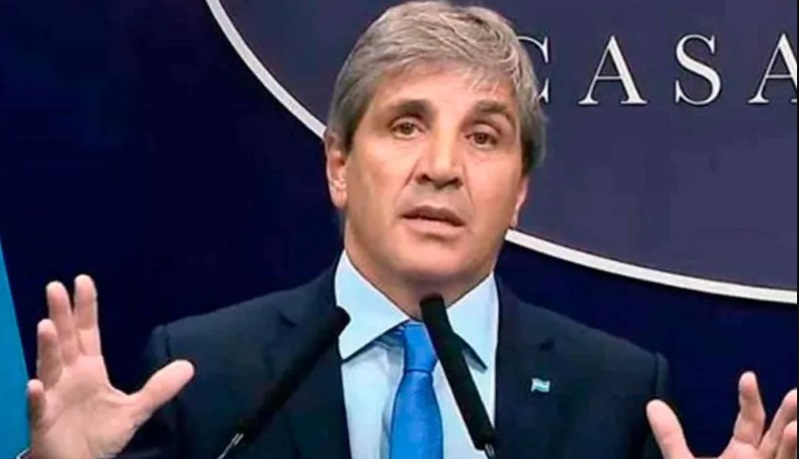
This Wednesday, the Ministry of Economy faced a new test with the bidding of debt in pesos, and the result turned on all alarms: Luis Caputo only managed to renew 61% of the maturities, leaving more than $ 5.7 billion released who can now press on the dollar. Not even the strategy of validating very high rates – some near or exceeding 70% annual – reached to convince financial capital, evidencing distrust in the economic program of the Milei government. The financial bicycle continues to turn, but every time with less impulse.
This time the treasure was solved for $ 14.8 billion and only managed to place $ 9.1 billion in the tender, leaving 39% without renewing. The numbers are overwhelming: the Government offered LECAP and BANCAP at rates that triple the expected inflation – for example, the LECAP as of September 12 paid 4.48% monthly (69.20% per year) and the one that expires at the end of September, 4.20% monthly (63.78% per year). Even the shortest, 15 days, closed with a rate of 4.28% monthly (65.33% per year), triple the inflation projected for the period. The message is clear: who bets on these treasure papers is guaranteed sidereal income, if compared to what other market instruments offer.
However, the financial capital looked at the re -joy government. For banks and investment funds, distrust is measured in rates: the “prize” they demand to stay in pesos grows every time they perceive risks. And the risks, in sight, multiply.
What is behind this failure to renew the debt? On the one hand, a structure that repeats the worst vices of the Argentine financial model: debt paid with more debt, but now, at much more expensive prices for the State and society. In July, to stop a run to the dollar after the disarmament of fiscal liquidity letters (Lefi), the recipe was validated “super rates” in the LECAP, even above what the secondary market pays. In less than two weeks, the reference rate jumped from 29% to 65% per year. A juicy business for speculators.
The official objective is clear: absorb as many pesos as possible to prevent them from going to the dollar and sustaining the “exchange peace” for which Milei and Caputo go out of trouble. But the cost of this policy is brutal. Not only because it implies transferring public resources – bill of pesos – to large banks and investment funds, but because the increase in credit hits consumption, investment and day to day of thousands of SMEs and families. Interest rates at these levels are directly recessive and end up suffocating the real economy.
The ghost of the dollar and the snowball
The question that everyone is asked is where they will go those $ 5.7 billion that were not renewed. The most feared answer: to press the price of the dollar. It has already passed in July, when the disarmament of the Lefi released more than $ 10 billion and a good part ended up feeding the demand for currencies, forcing the BCRA to intervene in the futures market to try to contain the jump. The risk that history is repeated is high, especially in a scenario of growing political and economic uncertainty.
Financial capital is not characterized precisely by its social sensitivity: it invests where it sees business and retires as soon as it smells problems. Today, the “market” distrusts the Milei-Caputo plan due to the lack of reserves in the BCRA and the political weakness of the government. Although from the ruling state that “this time it is different” the exchange delay, combined with permanent fiscal adjustment, increasing indebtedness, and a state to guarantee financial income we have already seen it repeatedly in Argentine history. Even with the IMF having disbursing US $ 14,000 million, the shortage of dollars persists and the current account deficit is increasingly worrying.
Milei’s government is deepening the debt scam. The ’90 and 2001 crisis libretto is repeated, but now with new actors and old acquaintances – capital, Sturzenegger – who already demonstrated for whom they govern. Lecap and usura feas bonds are an award for speculators and a time bomb for the great majorities. The debt paid over and over again, but never ends, because it only serves to feed the capital escape and concentrated capital businesses.
Meanwhile, the adjustment follows its route: cuts in retirement, health, funds for people with disabilities and state wages. The “fiscal balance” is only for those below. For large employers, there are decrease in retentions, tax reduction and the entire free court to move their millions without control. Milei’s speech that “there is no money” falls apart when the expense in interests and debt services is seen.
From the Left Front they argue that the only real exit for the crisis is to break with the IMF, ignore the illegitimate and fraudulent debt and turn all resources to solve the urgent problems of the majorities: health, education, salaries and housing. Paying the debt only perpetuates looting and adjustment. The opposite is to organize from below, with the strength of the workers and their families that fight every day against the misery they want to impose.
Source: www.laizquierdadiario.com

